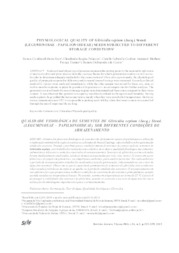Physiological quality of Gliricidia sepium (Jacq.) Steud. (Leguminosae - Papilionoideae) seeds subjected to different storage conditions.
Physiological quality of Gliricidia sepium (Jacq.) Steud. (Leguminosae - Papilionoideae) seeds subjected to different storage conditions.
Author(s): REIS, R. C. R.; PELACANI, C. R.; ANTUNES, C. G. C.; DANTAS, B. F.; CASTRO, R. D. de
Summary: Studies of seed physiological processes represent the starting point for the sustainable utilization of native or cultivated plant species from the caatinga biome for which germination studies are still scarce. In order to determine adequate methods for the conservation of Gliricidia sepium seeds, the physiological quality of propagules exposed to different conditions and times of storage were examined. Recently collected seeds of G. sepium were analyzed immediately, while the other sample was stored for three, six, nine, or twelve months in plastic or paper bags under refrigeration or at room temperature for further analysis. The germination rates of seeds from each storage regime were determined and these rates compared to their water content. It was observed that germination capacity was directly related to changes in seed humidity. Storing seeds in plastic bags yielded the best conservation, mainly when they were stored at low temperatures. However, even at temperatures near 25°C it was possible to prolong seed viability when their water content was controlled through the use of impermeable packing.
Publication year: 2012
Types of publication: Journal article
Unit: Embrapa Semi-arid Region
Observation
Some of Embrapa's publications are published as ePub files. To read them, use or download one of the following free software options to your computer or mobile device. Android: Google Play Books; IOS: iBooks; Windows and Linux: Calibre.
Access other publications
Access the Agricultural Research Database (BDPA) to consult Embrapa's full library collection and records.
Visit Embrapa Bookstore to purchase books and other publications sold by Embrapa.

